Introduction
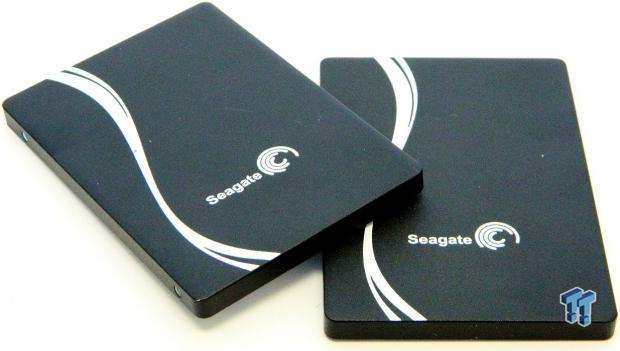
Link_A_Media or LAMD powered SSDs are not as common as Marvell or SandForce based SSDs. There are two major players that offer SSDs powered by LAMD controllers - Seagate and Corsair. The Seagate 600 series we have on the bench today is Seagate's current mainstream solid state storage solution.
The 600 series is Seagate's first large scale concerted effort to penetrate the mainstream consumer SSD market. Seagate has chosen to partner with LAMD and Toshiba to produce the 600 series SSDs. Seagate has had a long relationship with LAMD and collaborated with them in the past to produce controllers for Enterprise based SSDs.
We like the LAMD Amber LM87800 controller at the heart of the 600 Series SSD. First introduced to the world by Corsair in their Neutron Series of SSDs, the LAMD Amber FSP has already earned a reputation for being extremely reliability and delivering consistent performance in a steady state.
The type of NAND utilized in a SSD is every bit as important as the flash storage processor (controller) for performance and reliability. Toshiba's 19nm Type C 3K P/E toggle mode BGA NAND packages are as good as it gets these days and an excellent choice for Seagate's 600 series SSDs.
Seagate is a huge corporation and as such has the resources to write its own custom firmware for their SSDs. Having the ability to write their own custom firmware allows Seagate to tune the 600 Series' performance and reliability via in-house testing and validation.
Seagate's 600 series SSD is already a proven performer so what we want to explore of course is what that performance looks like magnified by RAID 0 and driven by the latest Intel chipset.
Specifications, Pricing and Availability
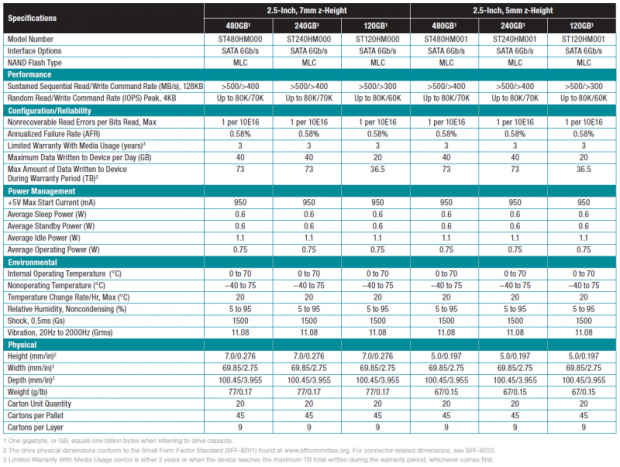
Seagate's 600 series is available in three capacity sizes - 120GB, 240GB and 480GB. Specifications list the 240GB 600 series SSD as capable of exceeding 500 MB/s sequential reads and exceeding 400 MB/s sequential writes. Random read/write speed is listed at up to 80,000/70,000 IOPS at 4K QD32. The 600 series is available in 7mm or 5mm z-height configurations.
Seagate backs the 240GB 600 series SSD with an industry standard limited three year warranty. The 240GB drives we are looking at today are warranted for a maximum of 73 terabytes of data written to the device during a three year period. The 240GB Seagate 600 is currently available from Amazon for $193 (80 cents per GB).
Since this is a RAID article, we are going to focus on performance rather than features. For a more in-depth look at the Seagate 600 series feature set, I will refer you to Chris Ramseyer's extensive review of the Seagate 600 240GB.
Now let's see what kind of performance we can squeeze from a pair of Seagate's latest SSDs in RAID 0.
Seagate 600 240GB
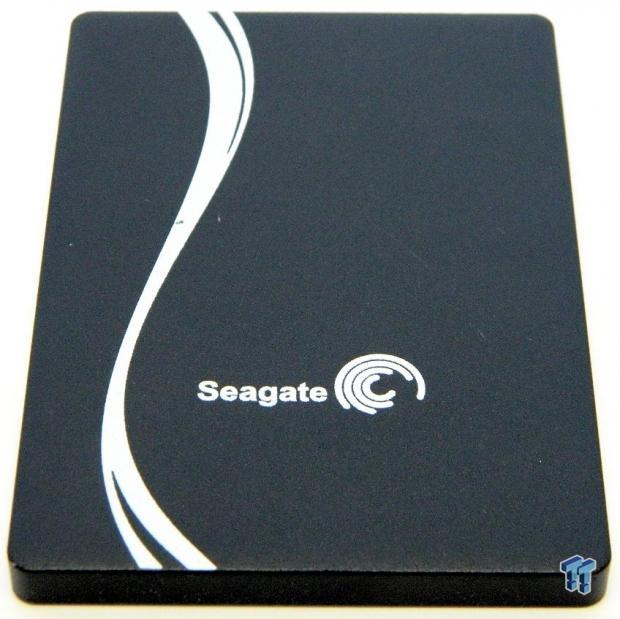
Our drives arrived bare so we don't have anything to show you as far as packaging goes.
The top and sides of the enclosure are formed from a single piece of cast glass beaded aluminum painted black. There is an attractive white wave graphic running across the top of the enclosure and a white Seagate logo beside it.
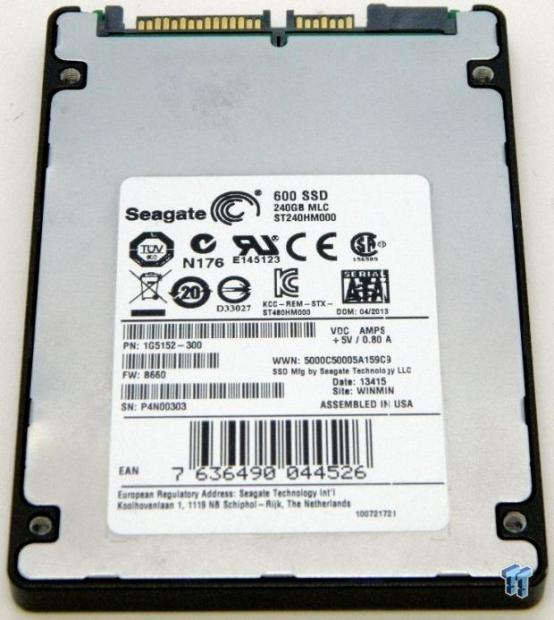
The bottom of the drive enclosure is formed from a piece of sheet metal. The bottom of the enclosure interlocks with the top making it tamper proof.
Centered on the bottom of the enclosure is a manufacturer's sticker that lists the drives part number, serial number, shipping firmware and other relevant information.
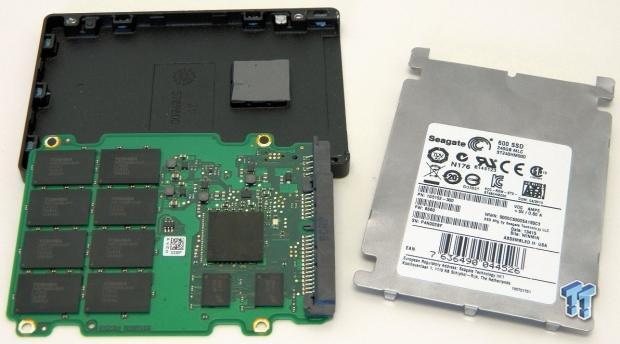
Here's what a Seagate 600 240GB SSD looks like completely disassembled.
The drives NAND array is located entirely on this side of the PCB, along with two DRAM buffer chips and a LAMD Amber LM87800 FSP (Flash Storage Processor). The reverse side of the PCB is devoid of components.
There is a raised portion of the drives cast aluminum enclosure that makes contact with a thermal pad that is in contact with the drives FSP.
Benchmarks - Test System Setup, Drive Properties & ATTO Baseline Performance
Desktop Test System
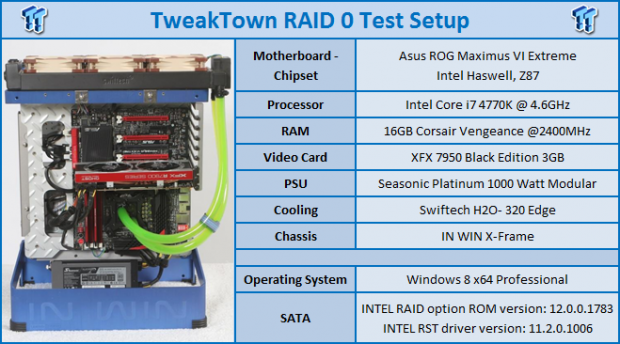
Drive Properties
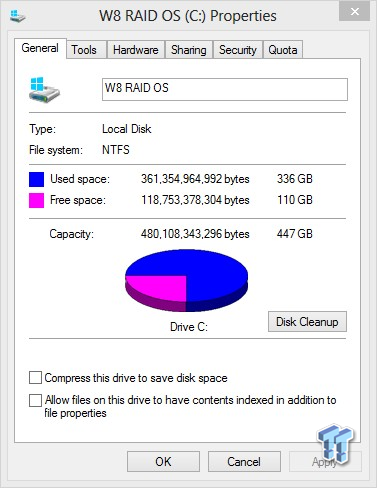
The majority of our testing will be done with our test drive/array as our boot volume. Our boot volume is 75% full for all OS Disk "C" drive testing, to mimic a typical consumer OS volume implementation. We're using 64K stripes for all our arrays. Write caching is enabled.
ATTO Baseline Performance
Version and / or Patch Used: 2.47
ATTO is a timeless benchmark used to provide manufactures with data used for marketing storage products.
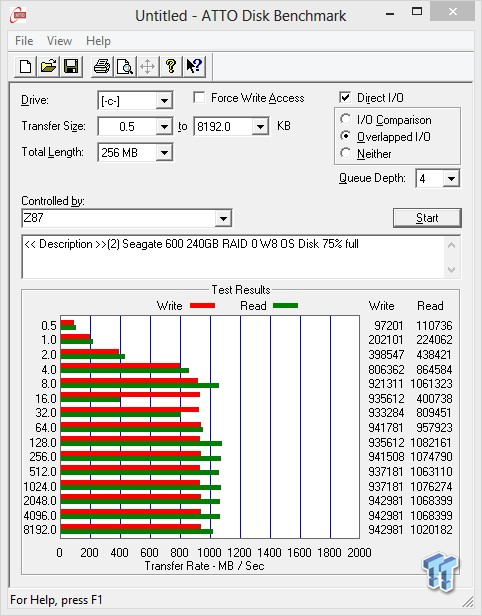
Excellent scaling - two drives have double the performance of a single drive.
Sequential Write
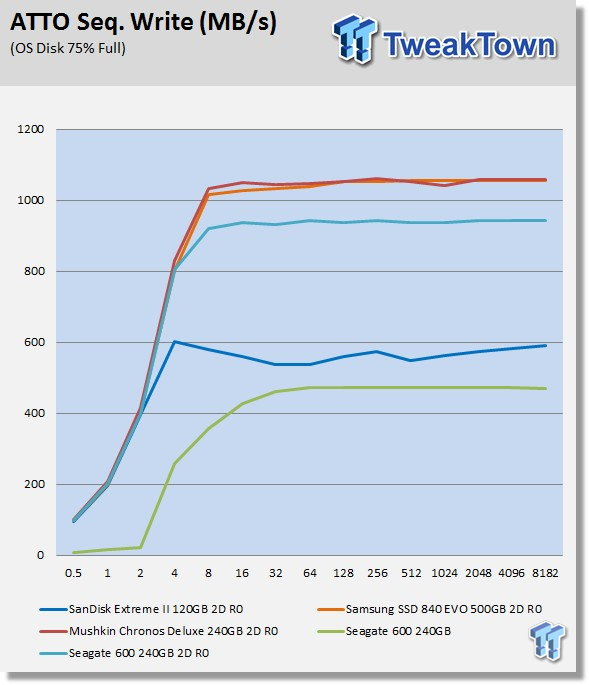
At very small transfer sizes of 2KB and below write caching enables our two-drive array to churn out ten times the performance of a single drive. Write performance ramps up quickly and remains steady throughout ATTO's range of transfer sizes. Maximum sequential write speed isn't as high as our Chronos Deluxe or EVO arrays.
Sequential Read
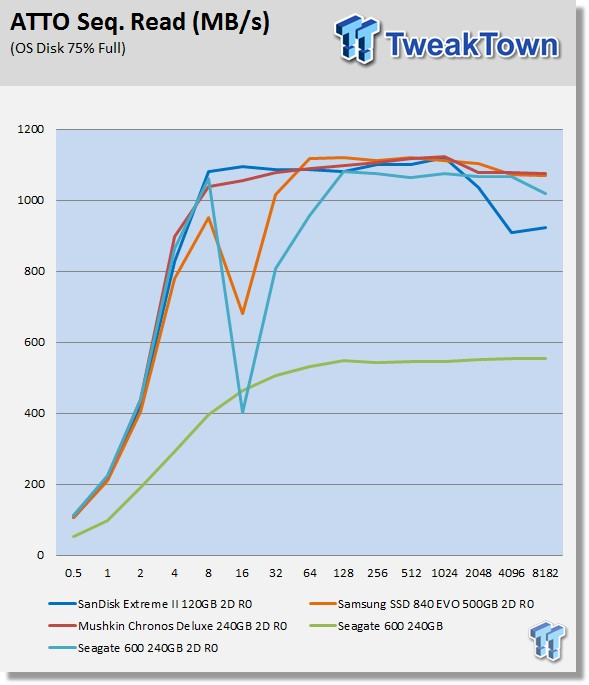
Both our 600 array and our EVO array have a performance drop off at 16KB transfers. This performance drop off recovers at larger transfers and is probably more of a testing anomaly than anything else.
There is no dip in performance from a single drive, which is why we believe this is a testing anomaly.
Benchmarks - Anvil Storage Utilities
Anvil Storage Utilities
Version and / or Patch Used: RC6
So what is Anvil Storage Utilities? First of all, it's a storage benchmark for SSDs and HDDs where you can check and monitor your performance. The Standard Storage Benchmark performs a series of tests, you can run a full test or just the read or the write test or you can run a single test, i.e. 4K QD16.
The software is used several different ways and to show different aspects for each drive. We've chosen to use this software to show the performance of a drive with two different data sets. The first is with compressible data and the second data set is incompressible data. Several users have requested this data in our SSD reviews.
0-Fill Compressible Data
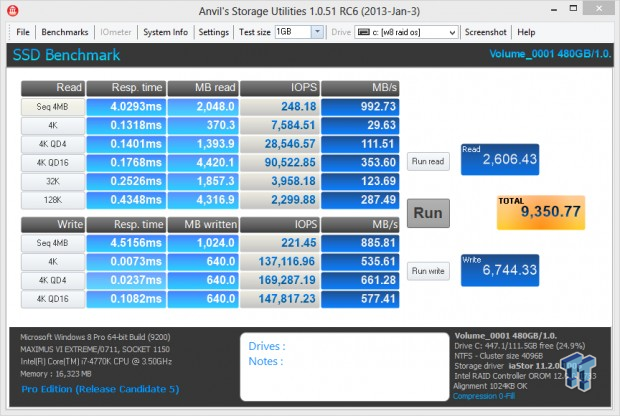
9300 points is a nice score. Not hyper-class level, but definitely upper enthusiast class performance.
0-Fill Compressible Read IOPS through Queue Depth Scale
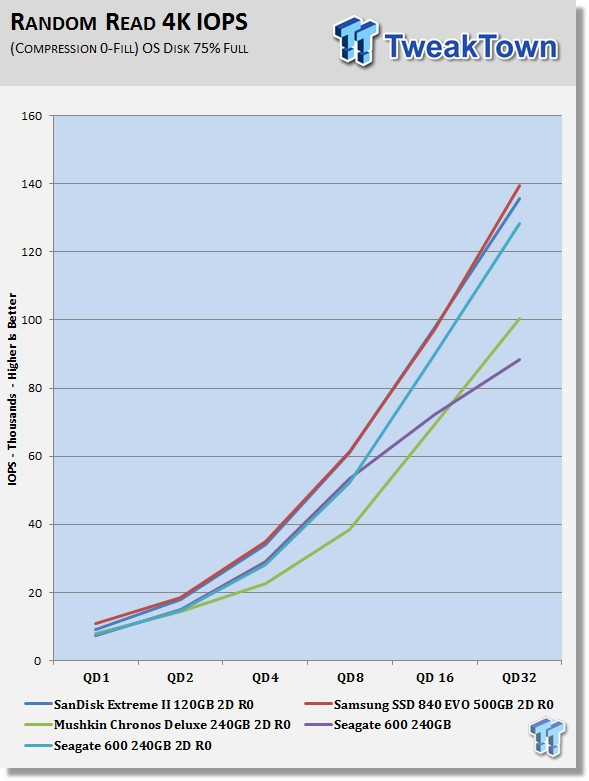
Good performance, not quite at the level of the two hyper-class arrays on our chart, but definitely better performance than our SandForce based array.
0-Fill Compressible Write IOPS through Queue Depth Scale
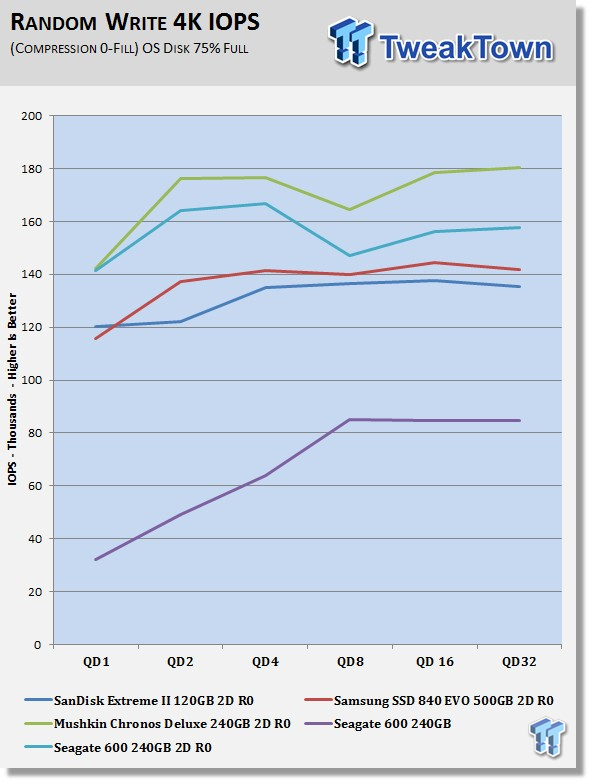
Write caching enables our array to put out over three times the performance of a single drive at 4K QD1. This time our Seagate 600 array manages to outperform both the EVO and Extreme II arrays. SandForce wins this one because the test data is compressible.
Compression 100% Incompressible Data
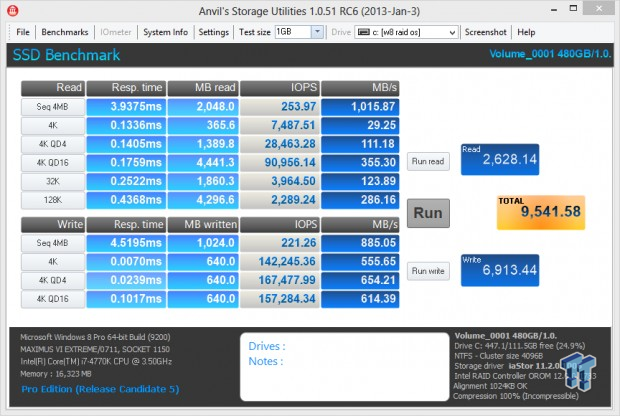
Even better scoring with incompressible data. This doesn't necessarily mean that the Seagate 600 prefers incompressible data, it's just a variation from one run to the next more than anything else.
Incompressible Read IOPS through Queue Depth Scale
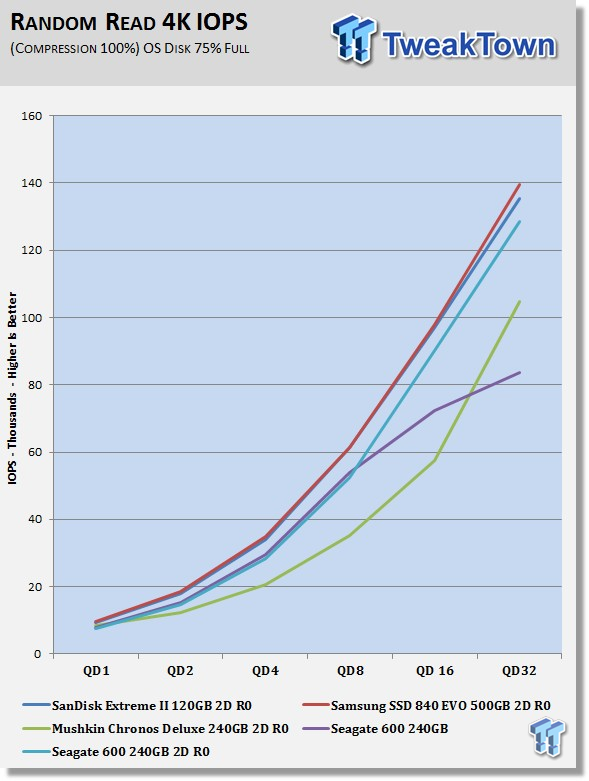
Reading incompressible data doesn't change the pecking order of the arrays on our chart.
Incompressible Write IOPS through Queue Scale
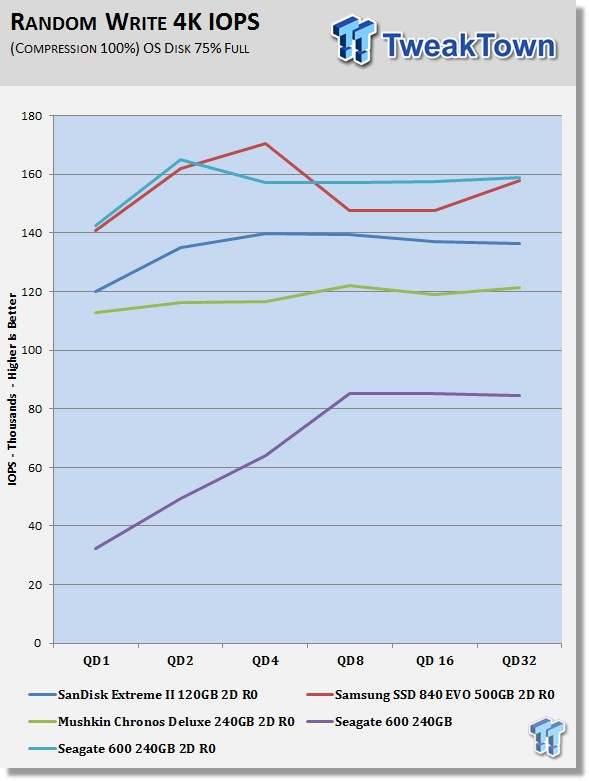
Writing incompressible data does change the pecking order of the arrays on our chart. When writing incompressible data, our Seagate 600 array manages to win this round by slightly beating out our EVO array with a more consistent performance.
Benchmarks - CrystalDiskMark
CrystalDiskMark
Version and / or Patch Used: 3.0 Technical Preview
Developer Homepage: http://crystalmark.info
Product Homepage: http://crystalmark.info/software/CrystalDiskMark/index-e.html
Download here: http://crystaldew.info/category/software/crystaldiskmark
CrystalDiskMark is disk benchmark software that allows us to benchmark 4K and 4K queue depths with accuracy.
Note: Crystal Disk Mark 3.0 Technical Preview was used for these tests since it offers the ability to measure native command queuing at 4 and 32.
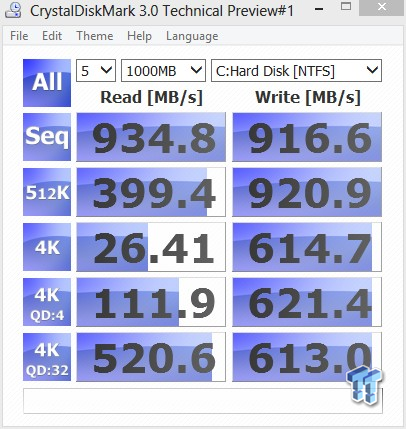
Read performance is pretty good, especially with commands stacked up at QD32. Write performance is freaking awesome.
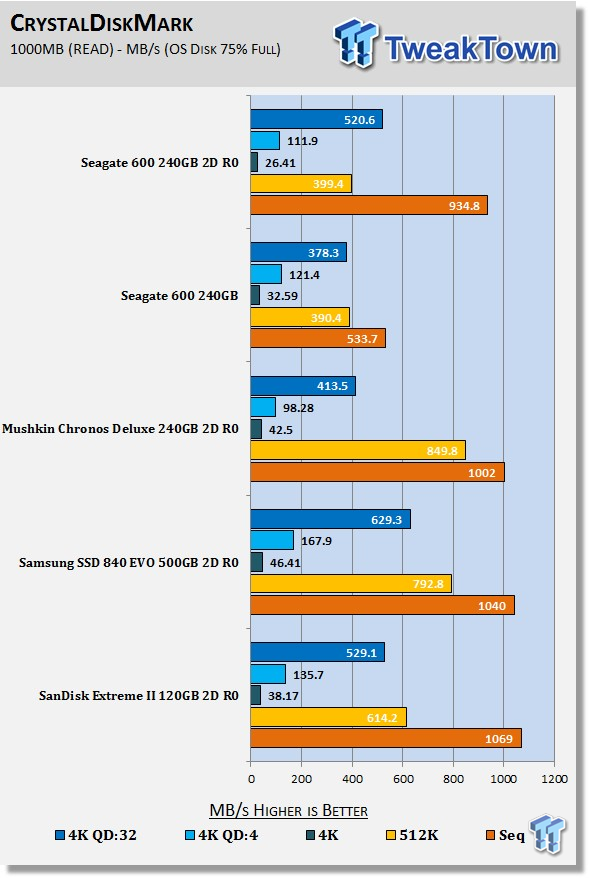
Sequential read performance is good, however two drives are not scaling quite as well as we would like to see until we hit 4K QD32. Our Seagate 600 array isn't as fast as the other arrays on our chart when reading data.
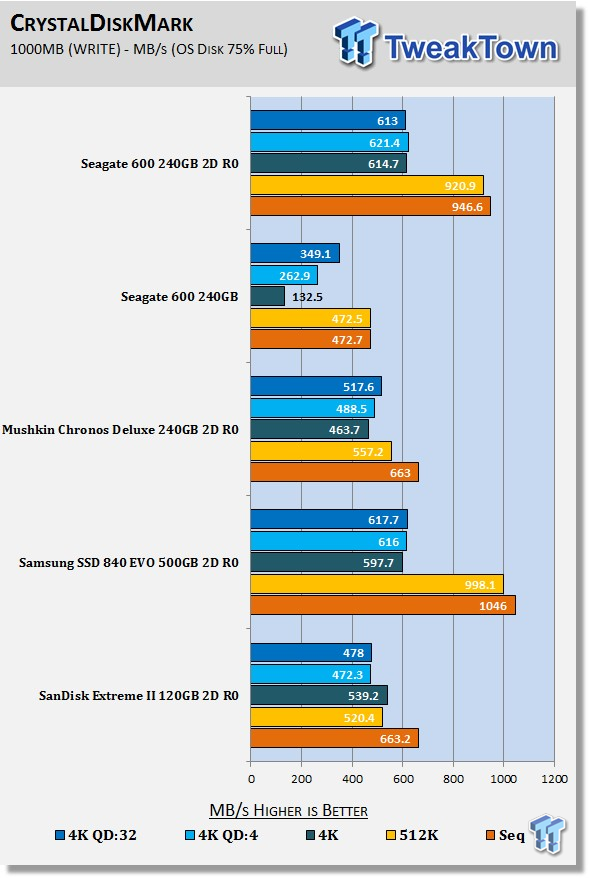
Writing data is what a Seagate 600 array does better than most. Only our EVO array is able to outperform our Seagate 600 array by the slightest of margins. The Seagate 600 array has the best 4K QD1 write performance of any array on our chart.
Benchmarks - AS SSD
AS SSD
Version and / or Patch Used: 1.7.4739.38088
Product Homepage: http://alex-is.de/PHP/fusion/news.php
Download here: http://alex-is.de/PHP/fusion/downloads.php
AS SSD determines the performance of Solid State Drives (SSD). The tool contains four synthetic as well as three practice tests. The synthetic tests are to determine the sequential and random read and write performance of the SSD. These tests are carried out without the use of the operating system caches.
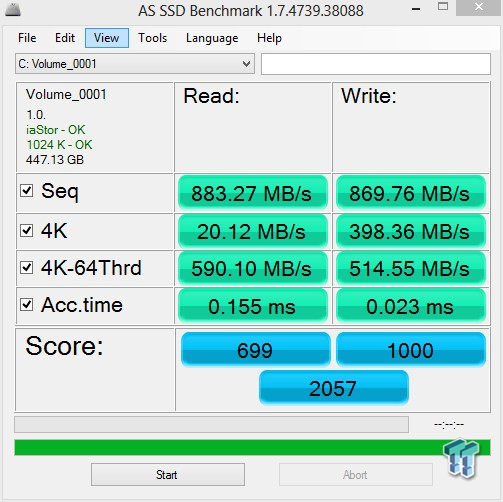
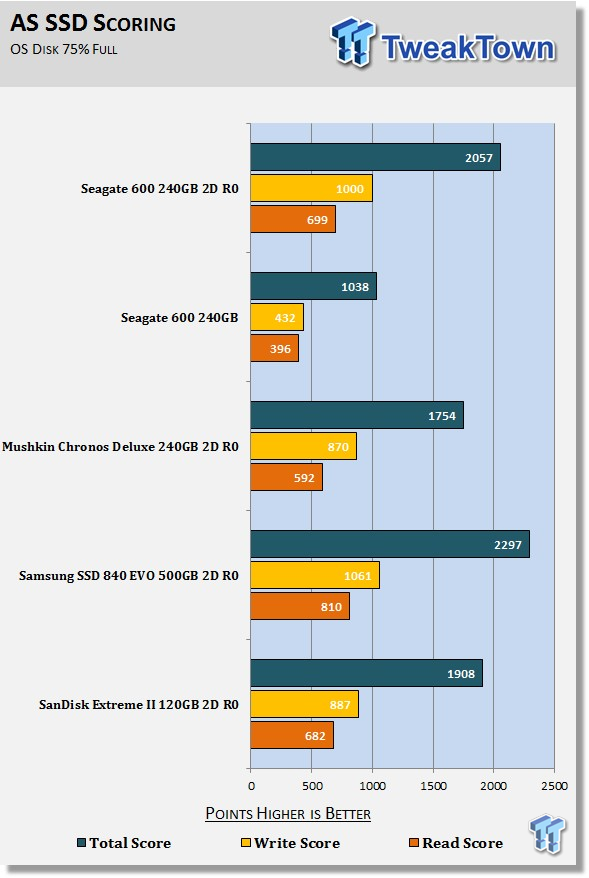
Our two-drive Seagate 600 array is almost able to double the score of a single drive and comes in second place, beating out the Chronos and Extreme II arrays.
Benchmarks - PCMark Vantage
PCMark Vantage - Hard Disk Tests
Version and / or Patch Used: 1.2.0.0
Developer Homepage: http://www.futuremark.com
Product Homepage: http://www.futuremark.com/products/pcmarkvantage

PCMark Vantage is the first objective hardware performance benchmark for PCs running 32 and 64 bit versions of Microsoft Windows Vista. PCMark Vantage is perfectly suited for benchmarking any type of Microsoft Windows Vista PC from multimedia home entertainment systems and laptops to dedicated workstations and high-end gaming rigs. Regardless of whether the benchmarker is an artist or an IT Professional, PCMark Vantage shows the user where their system soars or falls flat, and how to get the most performance possible out of their hardware. PCMark Vantage is easy enough for even the most casual enthusiast to use yet supports in-depth, professional industry grade testing.
The reason we like PCMark Vantage is because the recorded traces are played back without system stops. What we see is the raw performance of the drive. This allows us to see a marked difference between scoring that other trace based benchmarks do not exhibit. An example of a marked difference in scoring on the same drive would be empty vs. filled vs. steady state.
We run Vantage 3 ways. The first run is with the OS drive/Array 75% full to simulate a lightly used OS volume filled with data to an amount we feel is common for most users. The second run is with the OS volume written into a "Steady State" utilizing SNIA's guidelines (Rev 1.1). Steady state testing simulates a drive/arrays performance similar to that of a drive/array that has been subjected to consumer workloads for extensive amounts of time. The third run is a Vantage HDD test with the test drive/array attached as an empty lightly used secondary device.
OS Volume 75% full - Lightly Used
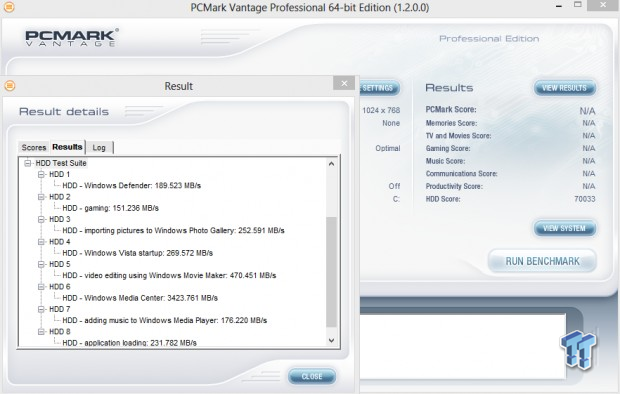
OS Volume 75% full - Steady State
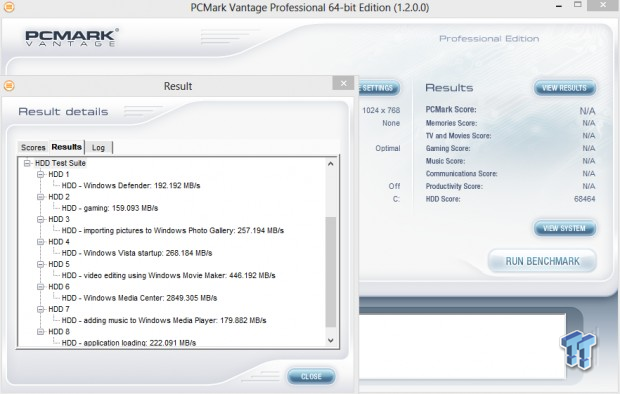
Secondary Volume Empty - Lightly Used
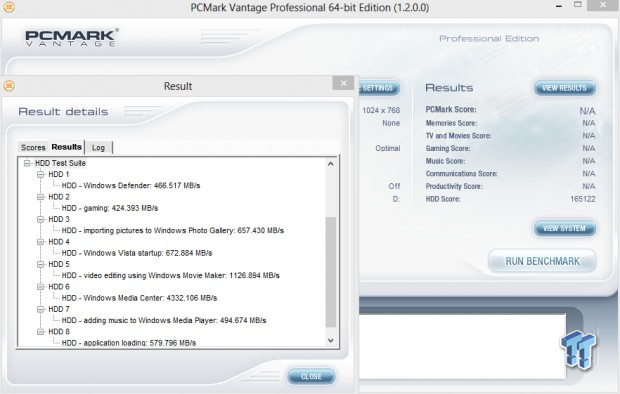
As you can see, there's a big difference between an empty drive/array and one that's 75% full/used and one that's in a steady state.
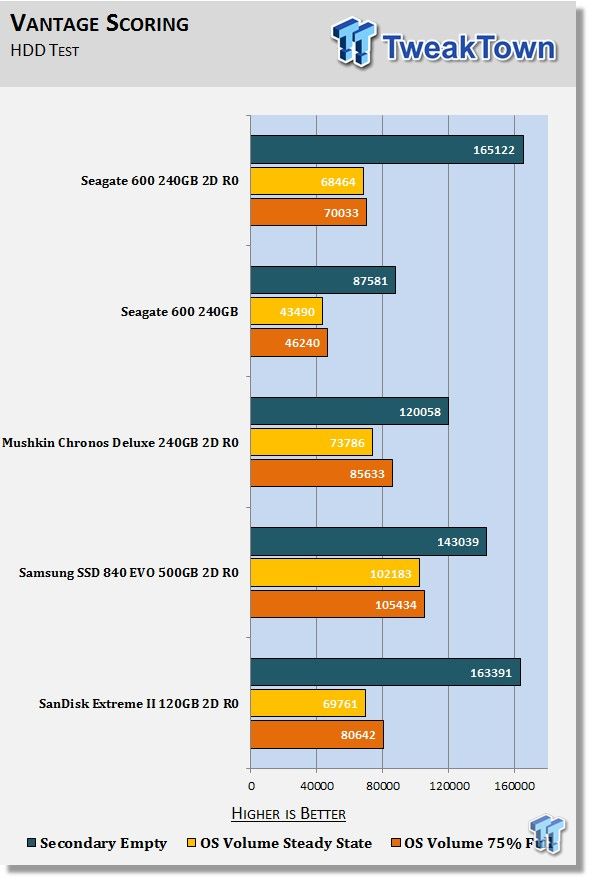
The important scores to pay attention to are "OS Volume Steady State" and "OS Volume 75% full". These two categories are most important because they are indicative of typical of consumer based user states.
Our Seagate 600 array's performance in a steady state is comparable to our Extreme II array. When our Seagate 600 array is attached as a secondary drive and empty, it beats the competition in this unrealistic scenario.
Like we've said a million times before, Vantage scoring means nothing without data on the drive/array, but we show it anyway just because that's how most other reviewers utilize Vantage.
Benchmarks - PCMark 7
PCMark 7 - System Storage
Version and / or Patch Used: 1.4.00
Developer Homepage: http://www.futuremark.com
Product Homepage: http://www.futuremark.com/benchmarks/pcmark7
PCMark 7 includes 7 PC tests for Windows 7 & 8, combining more than 25 individual workloads covering storage, computation, image and video manipulation, web browsing and gaming. Specifically designed to cover the full range of PC hardware from netbooks and tablets to notebooks and desktops, PCMark 7 offers complete PC performance testing for Windows 7 & 8 for home and business use.
We will look to the Raw system storage scoring for RAID 0 evaluations because it's done without system stops and therefore allows us to see significant scoring differences between drives/arrays.
OS Volume 75% full - Lightly Used
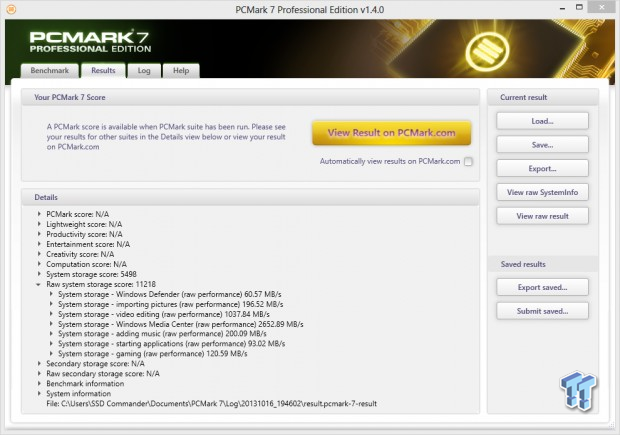
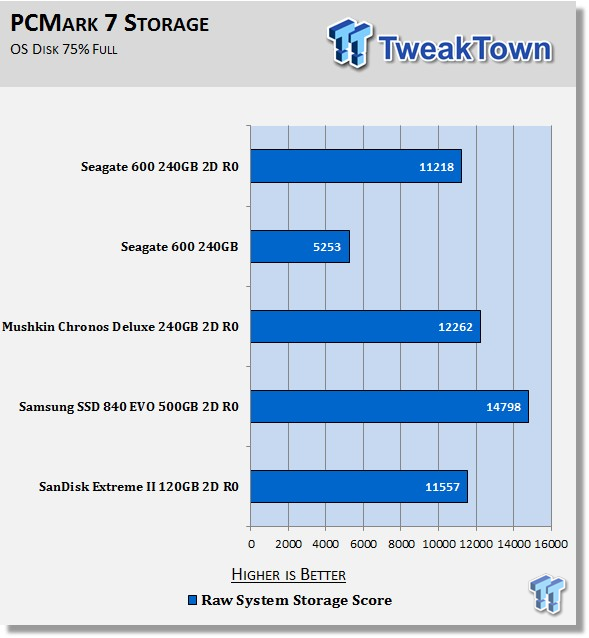
PCMark 7 backs up our Vantage results. Our Seagate 600 array comes in just behind our Extreme II array. Our two-drive array scores more than double what a single drive scores.
Benchmarks - PCMark 8
PCMark 8 - Storage Bandwidth
Version and / or Patch Used: 1.2.157
Developer Homepage: http://www.futuremark.com
Product Homepage: http://www.futuremark.com/benchmarks/pcmark8
PCMark 8 FutureMark's latest version of their popular series of PC benchmarking tools. Improving on previous releases, PCMark 8 includes battery life measurement tools and new tests using popular applications from Adobe and Microsoft. Whether you are looking for long battery life, or maximum power, PCMark 8 helps you find the devices that offer the perfect combination of efficiency and performance for your needs.
Use the PCMark 8 Storage benchmark to test the performance of SSDs, HDDs and hybrid drives with traces recorded from Adobe Creative Suite, Microsoft Office and a selection of popular games. You can test the system drive or any other recognized storage device, including local external drives. Unlike synthetic storage tests, the PCMark 8 Storage benchmark highlights real-world performance differences between storage devices.
PCMark 8's Storage Performance Benchmark is an absolute beast of a test. The benchmark beats the hell out of your drive/array for well over an hour resulting in a very thorough evaluation of a drives real-world performance.
OS Volume 75% full - Lightly Used
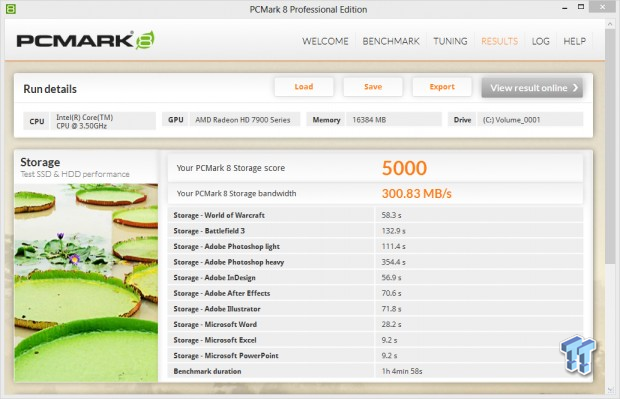
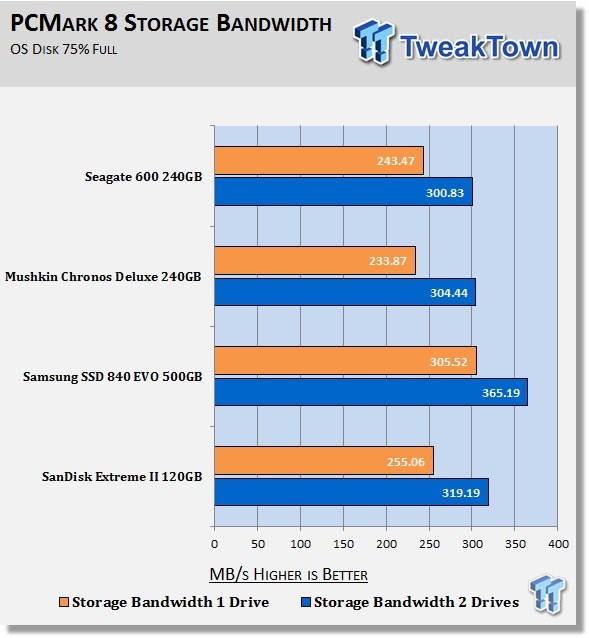
Our Seagate array puts up an average performance in this test. The Seagate 600 is a very good enthusiast-class SSD, but not on the same level of performance as hyper-class SSDs, like the Extreme II and EVO.
Secondary Volume Benchmarks - Disk Response Times
Iometer
Version and / or Patch Used: 1.1.0
Product Homepage: http://www.iometer.org
Download here: http://sourceforge.net/projects/iometer
Iometer is an I/O subsystem measurement and characterization tool for single and clustered systems. It was originally developed by the Intel Corporation and announced at the Intel Developers Forum (IDF) on February 17, 1998 - since then it's become wide spread within the storage industry.
We use Iometer to measure disk response times. Disk response times are measured at an industry accepted standard of 4K QD1 for both write and read. Each test is run twice for 30 seconds consecutively, with a 5 second ramp-up before each test. The drive/array is partitioned and attached as a secondary device for this testing.
Write Response
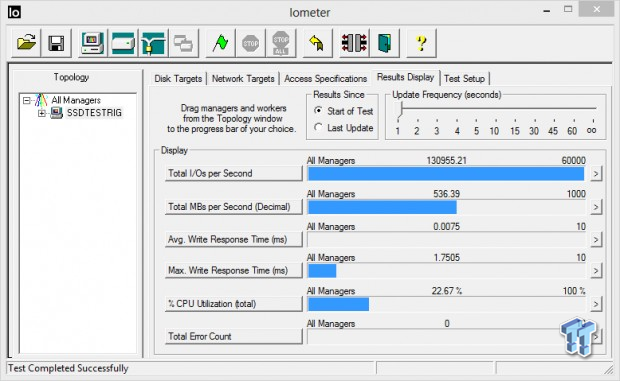
Read Response
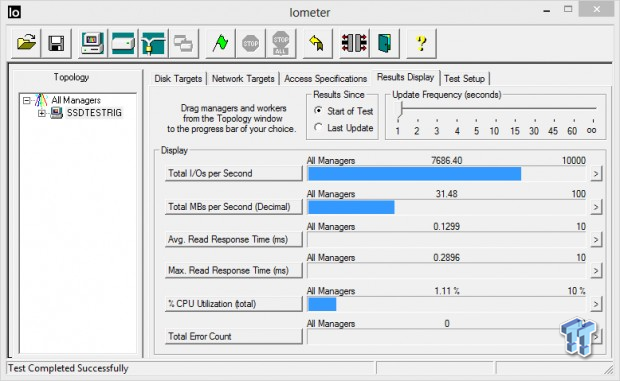
Average Disk Response
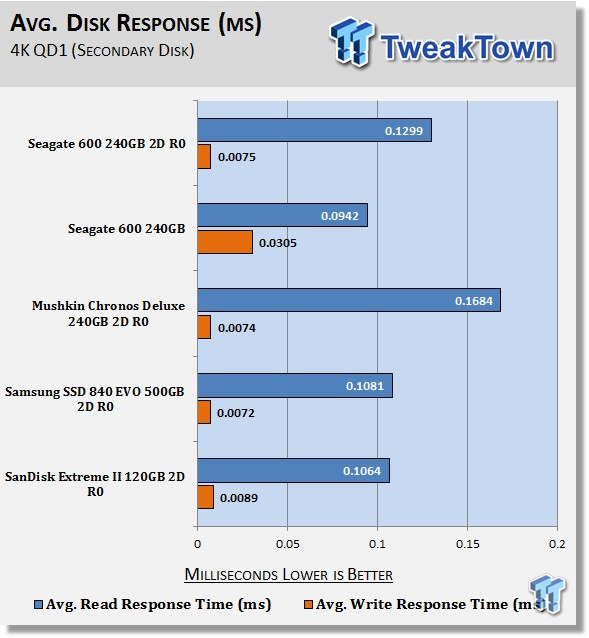
Write response times benefit most from RAID 0 because of write caching. There is a slight latency increase in read response times for an array vs. a single drive. Our array displays excellent write response and average read response times.
Maximum Disk Response
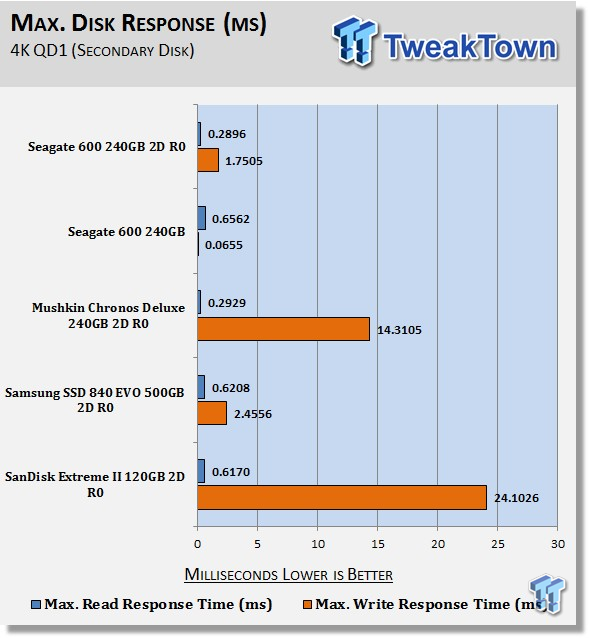
Maximum disk response times are difficult to nail down because they can vary so much from one run to the next, even when running the same drive.
We chart them anyway, because while they may vary from one run to the next, the chart gives us a pretty good overall picture of what to expect from our particular test subject. Low maximum latency is a valuable attribute of LAMD controllers. Low maximum latency is a key ingredient to consistent long term performance and our Seagate 600 array outperforms the rest of the arrays on our chart in this metric.
Secondary Volume Benchmarks - Blackmagicdesign's Disk Speed Test
Disk Speed Test
Version and / or Patch Used: 2.1.1
Product Homepage: http://www.blackmagicdesign.com
Disk Speed Test is an easy to use tool to quickly measure and certify your disk performance for working with high quality video! Simply click the start button and Disk Speed Test will write test your disk using large blocks of data, and then display the result. Disk Speed Test will continue to test writes and reads from your disk so you can evaluate both performance and readability over time.
We rate a drive/arrays video capabilities by the number of different categories that the device is capable of passing. The maximum number of tests that are possible to pass are 45 write tests and 45 read tests. We chart the number of tests a disk/array is capable of passing for a comparison of one drive/array verses another.
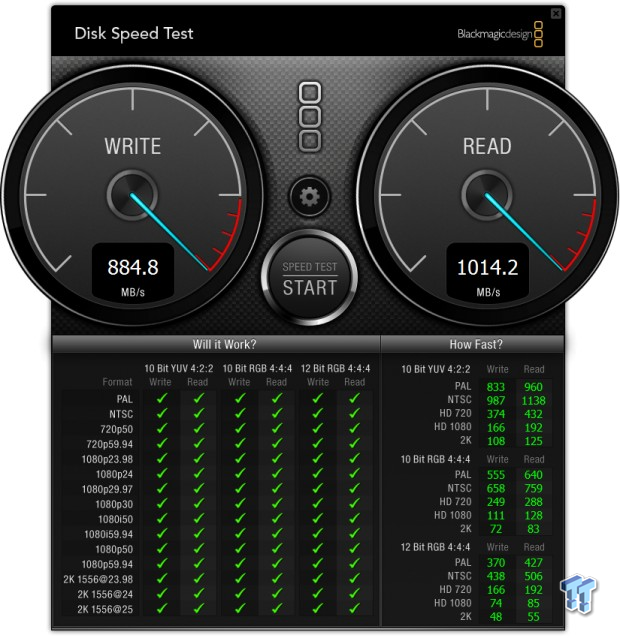
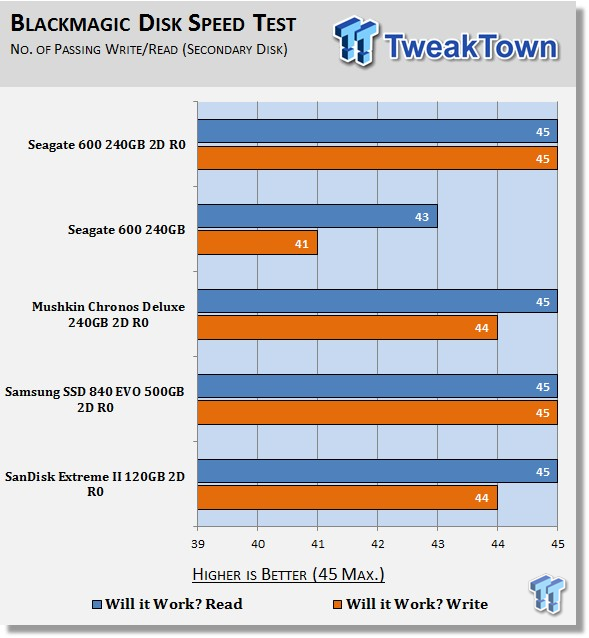
It's very hard for a single drive to be completely HD video capable. This is why serious video processing is almost exclusively done utilizing RAID arrays.
A Seagate 600 240GB R0 array is completely HD video capable. A Seagate 600 array with its consistent performance over time and high quality components make it an ideal choice for heavy duty video processing.
Secondary Volume Benchmarks - DiskBench
DiskBench - Directory Copy
Version and / or Patch Used: 2.6.2.0
Developer Homepage: Nodesoft
Product Homepage: DiskBench
Download here: http://www.nodesoft.com/diskbench/download
We use DiskBench to time a 28.6GB block (9,882 files in 1,247 folders) of mostly incompressible random data as it's transferred from our OS array to our test drive/array. We then read from a 6GB zip file that's part of our 28.6GB data block to determine the test drive/arrays read transfer rate. The system is restarted prior to the read test to clear any cached data, insuring an accurate test result.
Write Transfer Rate
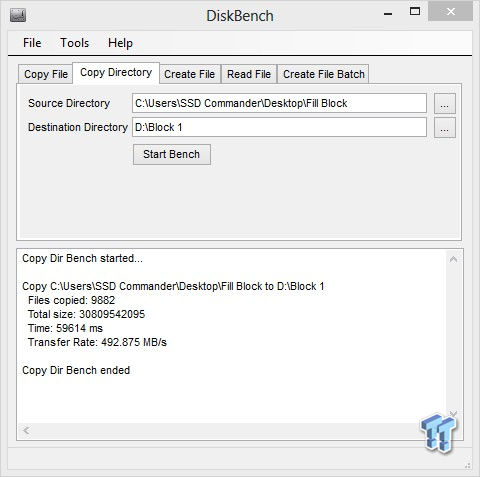
As we expected, we see very good write performance.
Read Transfer Rate
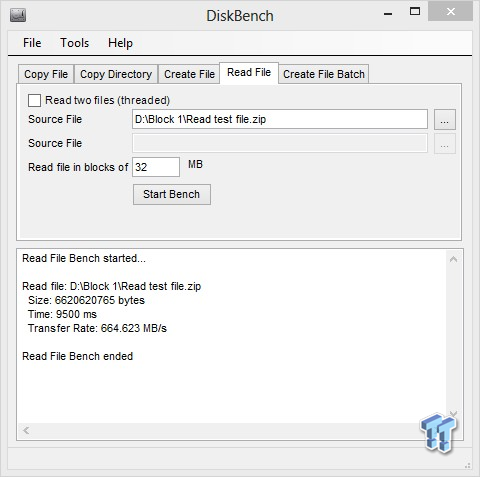
Here we see about a 200 MB/s improvement over a single 240GB 600 series drive.
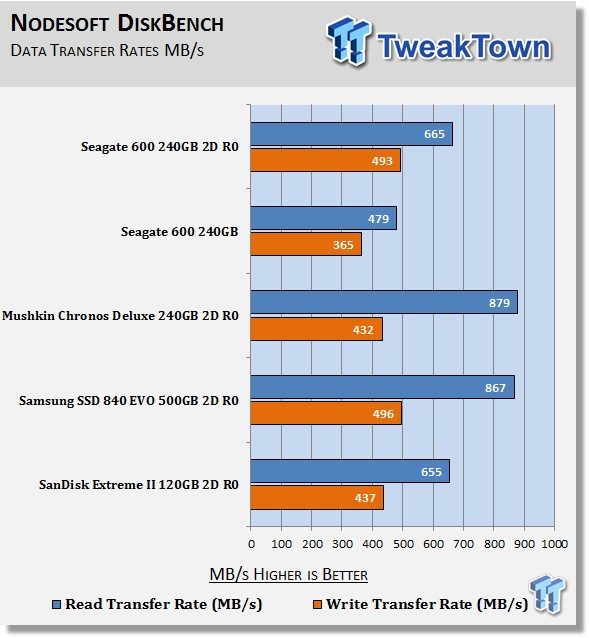
A Seagate 600 series array can run with the best when writing data, but isn't in the same league as our Chronos and EVO arrays when reading data. A 600 Series array has nearly identical performance to an Extreme II array when transferring large chunks of data.
Final Thoughts
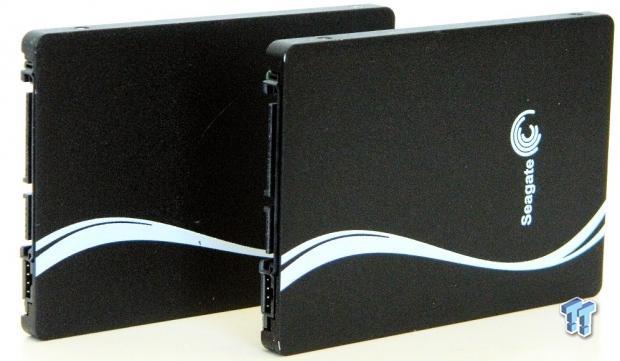
Solid state storage is the most important performance component found in a modern system today. Without it, you do not even have a performance system.
The 600 series is Seagate's first real push to carve out a significant chunk of the consumer SDD space. Seagate has built a reputation for delivering storage solutions with rock-solid performance and reliability through extensive validation and compatibility testing. This is the reason Seagate is the world's largest purveyor of non-volatile storage.
We feel that Seagate has hit a home run with their 600 series of SSDs. Seagate has chosen its partners carefully, resulting in an SSD that is quality built and utilizing proven components. The LAMD Amber controller powering the 600 series was born from the enterprise sector where reliability and consistent performance are the name of the game. Pairing Link_A_Media's Amber LM87800 FSP with Toshiba Toggle NAND is a recipe for success as we see it.
Looking back at our testing, we see that in certain write intensive scenarios Seagate's 600 series can deliver performance that's second to none. What stands out in my mind is how well our array maintained very low maximum latency response times. This low latency is a testament to the LAMD Amber's enterprise pedigree.
The Seagate 600 240GB SSD is aesthetically pleasing and has a quality feel to it. I like the monochromatic, minimalistic styling Seagate chose for the 600 Series. In my book, sometimes less is more, and I think Seagate's design is on point.
I think there is a bit of pertinent information that's worth mentioning in closing. SK Hynix bought Link_A_Media and now has full control over who gets to purchase the LAMD Amber LM87800 controller. So now, if a vendor wants to utilize an Amber LM87800 controller in their SSD, they must buy SK Hynix NAND as part of a package deal. SK Hynix NAND isn't as good as Toshiba's at this point, so if you want a LAMD controlled SSD that has the superior performance of Toshiba NAND, Seagate's 600 series SSD may be one of your last chances to get your hands on this potent combination.
RAIDing two or more drives together provides you with storage that takes performance to the next level and is something I recommend you try. Once you go RAID, there's no going back.


 United
States: Find other tech and computer products like this
over at
United
States: Find other tech and computer products like this
over at  United
Kingdom: Find other tech and computer products like this
over at
United
Kingdom: Find other tech and computer products like this
over at  Australia:
Find other tech and computer products like this over at
Australia:
Find other tech and computer products like this over at  Canada:
Find other tech and computer products like this over at
Canada:
Find other tech and computer products like this over at  Deutschland:
Finde andere Technik- und Computerprodukte wie dieses auf
Deutschland:
Finde andere Technik- und Computerprodukte wie dieses auf